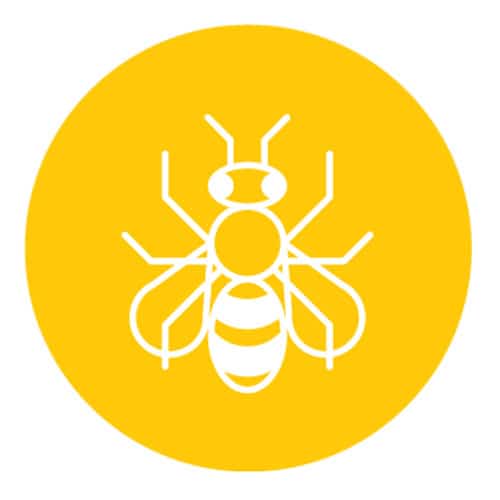
Bee Public: A Firsthand Look at Beekeeping
Editor’s Note: From raising chickens and goats to knitting a masterpiece to pickling and preserving, we present your ultimate guide to mastering the homespun, do-it-yourself life in Indy. So slip on your gardening gloves, and let’s get dirty. (See all Indy DIY stories here.)
When a swarm of bees appeared, dangling like a Christmas ornament from a tree branch high above the urban farm I worked on (the one I’d just quit my big-girl job in advertising for), I knew I’d chosen the correct path. As far as omens go, that’s a pretty good one, I thought. Among my agricultural endeavors, I’d also taken up beekeeping, a hobby that, until this very moment, was mostly based in theory. I’d attended a local workshop called Bee School and perused books and blogs on urban homesteading and rooftop beekeeping. It was time to put my honey where my mouth was. Time to catch my first swarm.

The bees hardly took notice as I gingerly handled the branch where they’d settled, a massive, throbbing superorganism. Sure, I could have ordered my colony through the mail, but I would have missed out on coming face-to-face with tens of thousands of bees. Some old-timers say you officially become a beekeeper once you’ve been stung. (Which, for the record, has happened to me a handful of times, and I’ll accept all the blame. Honeybees sting only when they feel threatened. They’d rather not sting you at all—when they do, they die.) For me, this swarm rescue was my beekeeping rite of passage.
I shook the branch, and the clump of bees fell with a dull thunk into one of my empty hives. I unceremoniously closed the lid. Will they like their new home? Will they like me? I wondered. I was already emotionally invested.
Truth be told, I had been for a while. Headlines about the declining bee population had my attention years ago. Since 2006, we’ve lost more than one-third of our honeybee colonies nationwide, due in major part to Colony Collapse Disorder, an alarming phenomenon that occurs when the bees mysteriously desert their hive and die. And if we lose bees, we don’t just miss out on honey—the likes of vegetables, fruits, nuts, avocados, chocolate, and coffee are also endangered. All of these crops require pollination to produce, and honeybees are hands-down the best at it. As they move from flower to flower to gather nectar, they wind up trading favors: food for the bee, fertilization for the plants. One out of every three bites of food we eat was made possible by a bee. So no bees, no food.
The swarm stayed put in the hive I set up for them in the corner of Growing Places Indy’s urban farm, where their powers of pollination were welcome (and noticed!). I kicked off a project and blog, Bee Public, with the mission to connect local urban farms with hives of their own and do what I can to raise awareness about my perky friends, their declining numbers, and their role in our food system. To date, I’ve set up five hives across the city at places like Arlington Farms, South Circle Farm, and Big City Farms. Every two weeks or so, I’d “work the bees” (a beekeeping term for inspecting the hive to make sure everything’s a-okay), becoming bolder and better at reading their signals.
Perhaps I wasn’t truly a beekeeper, though, until the day I experienced another, nearly inevitable and devastating rite of passage: losing a hive. On a routine visit to Arlington Farms, one hive’s lid came away without resistance, no longer securely sealed by the bees’ sticky propolis (think: bee glue). Inside: 10 barren frames, peppered with only a few dejected bees. And there I stood crying over them. This is part of it, I repeated like a mantra, being a beekeeper.
And now, as I write this, the bees in my remaining healthy hives huddle together in a ball, rotating to create warmth as they feast on the proverbial fruits of their labor: sweet, nourishing honey. This month, they will pour out of the hive into the warm sunshine and rekindle their romance with the blooming spring flowers.
These are the inner workings of their complex society, one we’ve barely begun to understand. Some days the bees seem almost like tiny robots, bent on a mission. Other days, dramatic scenes unfold: dancing, swashbuckling, even battles to the death between virgin queens for a chance at the crown. To bear witness to it all will change you. These creatures, tiny as they are, have a way of making you feel a sense of something bigger than yourself.
This article appeared in the April 2014 issue.





